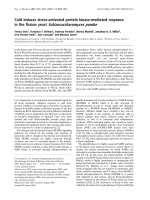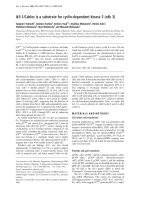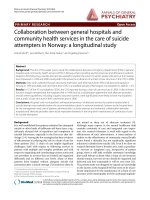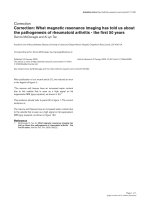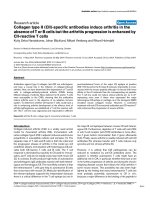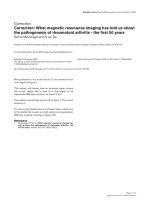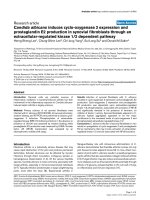Báo cáo y học: "Candida albicans genome sequence: a platform for genomics in the absence of genetics" potx
Bạn đang xem bản rút gọn của tài liệu. Xem và tải ngay bản đầy đủ của tài liệu tại đây (65.76 KB, 3 trang )
Genome Biology 2004, 5:230
comment
reviews
reports deposited research
interactions
information
refereed research
Minireview
Candida albicans genome sequence: a platform for genomics in the
absence of genetics
Frank C Odds, Alistair JP Brown and Neil AR Gow
Address: Aberdeen Fungal Group, Institute of Medical Sciences, Aberdeen AB25 2ZD, UK.
Correspondence: Frank C Odds. E-mail:
Abstract
Publication of the complete diploid genome sequence of the yeast Candida albicans will accelerate
research into the pathogenesis of Candida infections. Comparative genomic analysis highlights genes
that may contribute to C. albicans survival and its fitness as a human commensal and pathogen.
Published: 11 June 2004
Genome Biology 2004, 5:230
The electronic version of this article is the complete one and can be
found online at />© 2004 BioMed Central Ltd
For several years investigators studying the pathogenic yeast
Candida albicans have had internet access to partial
genomic sequence information, as the Stanford DNA
Sequencing and Technology Center generously released data
at several stages during their sequencing project [1]. The
publication of the full diploid sequence of this fungus [2]
represents a landmark in the history of Candida research
and is the culmination of more than ten years of work. The
drive for the C. albicans genome sequence originated at the
University of Minnesota with the early interest of Stewart
Scherer and Paul T. Magee in the molecular genetics of
C. albicans [3]; the sequencing itself is the product of the
Stanford Genome Technology Center, headed by Ron Davis.
Davis and his team have succeeded in overcoming consider-
able computational hurdles to eliminate the problems of
aligning sequence contigs for an organism with no known
haploid state. Heterozygosity at numerous alleles originally
resulted in single-copy genes being assigned to two distinct
contigs. The now-completed diploid genome sequence,
known as Assembly 19, is the result of novel alignment
methods that make use of physical mapping data, paired
plasmid clone sequences and archived GenBank sequences
to assemble a set of supercontigs representing the diploid
genome sequence.
C. albicans is unique among fungal pathogens in terms of
the diversity of infections it can cause. The fungus is a
normal gut commensal in the majority of humans, but it is
also able to infect mucosal surfaces, skin and nails when
local antimicrobial defences are impaired, and it can spread
via the bloodstream to infect deep tissues in severely
immunocompromised individuals [4,5]. Comprehensive
understanding of the pathogenesis of these many forms of
Candida infection in terms of the molecular cross-talk
between host and pathogen is an obvious prerequisite to
progress in their diagnosis and treatment. The availability of
a full diploid genome sequence provides an invaluable tool
for researchers in the field.
The main facts and figures of the C. albicans genome
sequence are as follows. Eight chromosomes (historically
named 1-7 and R) constitute a haploid genome size of 14,851
kilobases (kb), containing 6,419 open reading frames (ORFs)
longer than 100 codons, of which some 20% have no known
counterpart in other available genome sequences. The codon
CUG, which is translated abnormally by C. albicans as serine
rather than leucine, is found at least once in approximately
two-thirds of ORFs.
The C. albicans isolate used for the sequencing project turns
out to have been an excellent representative choice. Strain
SC5314 was used in the 1980s by scientists at the E.R. Squibb
company (now Bristol-Myers Squibb) for their pioneering
studies of C. albicans molecular biology. It was engineered by
Fonzi and Irwin [6] to provide the uridine autotrophic
mutant that has been essential to most subsequent molecu-
lar genetic research into C. albicans. The strain is usually
described merely as a ‘clinical isolate’, but it is worth setting
on record that SC5314 was originally isolated from a patient
with generalized Candida infection by Margarita Silva-
Hutner at the Department of Dermatology, Columbia
College of Physicians and Surgeons (New York, USA). The
original isolate number was 1775 and the strain is identical
with strain NYOH#4657 in the New York State Department
of Health collection. (This information was provided by Joan
Fung-Tomc at Bristol-Myers Squibb as a personal communi-
cation.) SC5314 belongs to the predominant clade of closely
related C. albicans strains that represents almost 40% of all
isolates worldwide, as determined by DNA fingerprinting [7]
and multi-locus sequence typing (A. Tavanti, A.D. Davidson,
N.A.R.G., M.C.J. Maiden and F.C.O., unpublished observa-
tions). It is highly susceptible to all clinically used antifungal
agents (F.C.O., unpublished observations) and hence its
genome sequence forms an excellent reference for compari-
son with drug-resistant isolates. Furthermore, this strain is
highly virulent in animal models of Candida infection [8],
and its genome sequence can therefore be presumed to
encode most or all of the species’ virulence factors.
Unlike most yeasts, C. albicans is a diploid organism with no
known haploid phase, and for a long time it was considered
to be asexual. But genome sequencing has profoundly
altered our understanding of this organism. Early assemblies
of the C. albicans genome sequence revealed a mating-type
(MAT-like) locus [9] that led to the engineering of mating-
competent strains [10,11]. Further work led to the identifica-
tion of a natural mating-competent form that mates
naturally at high frequency to give a tetraploid gamete [12].
So far, attempts to demonstrate meiosis, and thereby com-
plete a sexual cycle, have been unsuccessful [2], although the
C. albicans genome has revealed a nearly complete reper-
toire of genes homologous to those predicted to execute the
essential stages of meiosis in the yeast Saccharomyces cere-
visiae [13]. Nevertheless, a parasexual cycle has been com-
pleted following the description of in vitro conditions that
promote concerted chromosome loss from tetraploids to
generate diploid segregants [14], and this is likely to be a
valuable experimental tool in the future.
The assembly of a complete diploid genome sequence for
SC5314 has allowed a reliable estimate of the frequency of
heterozygosities in C. albicans of 4.21 polymorphisms per
kb, or 1 polymorphism per 237 bases [2]. These heterozy-
gosities are distributed unevenly across the C. albicans
genome, however, with the highest prevalence on chromo-
somes 5 and 6. Highly polymorphic loci include the mating
type-like (MTL) locus and a region on chromosome 6 that
encodes several genes in the agglutinin-like sequence (ALS)
gene family, thought to be involved in adhesion to and inter-
action with host surfaces [15]. Nevertheless, over half of the
approximately 6,400 C. albicans genes contain allelic differ-
ences, and two-thirds of these polymorphisms are predicted
to alter the protein sequence. Furthermore, considerable
allelic variation in the C. albicans genome also results from
tandem repeat sequences, with many trinucleotide tandem
repeats located in coding regions of the genome [2]. This
suggests that the frequency with which seemingly equivalent
heterozygous mutants display phenotypic differences might
be higher than expected. Indeed there are a number of
reported cases of this (see, for example, [16]).
What can be gleaned from the genome sequences of a
pathogen such as C. albicans (and from other related fungi)?
C. albicans has rarely been isolated in nature away from an
animal host and has probably co-evolved along with humans
for millions of years. It is presumed, therefore, that the
present-day C. albicans genome contains the information
that enables this fungus to thrive in its human host in com-
petition with the immune system and with other microflora.
There are more than 1,000 C. albicans genes of unknown
function that have no obvious ortholog in S. cerevisiae or the
fission yeast Schizosaccharomyces pombe. These genes are
of particular interest to those interested in fungus-host
interactions, because many might play roles in the infection
process. The genome of the closely related species Candida
dubliniensis is now being sequenced. C. dubliniensis is the
nearest known phylogenetic neighbour to C. albicans and
infects humans but is less virulent in animal models [17].
Hence, comparisons of the two Candida genome sequences
may provide important clues about C. albicans genes that
contribute to its success as a human pathogen.
The genome sequence of the next most prevalent serious
agent of systemic fungal disease, Aspergillus fumigatus, will
also be released this year. This fungus primarily infects the
lungs of immunocompromised patients [18], whereas the
main focus of C. albicans and C. dubliniensis infections is
the kidneys [5]. Also, A. fumigatus has evolved as a sapro-
phyte, decomposing leaf litter, whereas C. albicans appears
to have an obligate association with mammalian hosts.
Hence, comparative analyses of the genome sequences of
these fungi is likely to provide important insights into the
evolution of niche-specific functions related to pathogenesis
in humans. There are now more than forty fungal genome-
sequencing projects underway, including representatives of
almost all major groups pathogenic for humans [19]. The
C. albicans genome sequence is likely to stimulate many new
investigations that probe the nature of fungal pathogenesis
and evolution.
For now, the C. albicans genome sequence offers clues about
the means by which C. albicans thrives in its host. For
example, C. albicans has numerous large gene families,
some of which encode known virulence attributes - such as
secreted aspartyl proteinase (SAP) genes, secreted lipase
(LIP) genes, agglutinin (ALS) genes and genes involved in
230.2 Genome Biology 2004, Volume 5, Issue 7, Article 230 Odds et al. />Genome Biology 2004, 5:230
iron assimilation. Other gene families identified by genome
sequencing may also contribute to the fitness of C. albicans
in at least one of the niches it occupies and/or to its patho-
genicity. C. albicans also contains multiple copies of genes
involved in the tricarboxylic acid cycle, oligopeptide trans-
port and sphingomyelin degradation. These may contribute
to the efficient assimilation of available carbon sources when
the fungus is growing in different microenvironments within
the host. Also, the increased emphasis upon sulfur metabo-
lism, compared with S. cerevisiae [2], might reflect an
increased reliance upon glutathione metabolism and the rel-
ative resistance of C. albicans to oxidative stresses [20]. Pre-
sumably these would help the fungus resist oxidative killing
by the host’s immune defences. These (and other) specula-
tions that emerge from scrutiny of the genome sequence now
need to be tested experimentally.
To summarize, the C. albicans genome sequence is a very
important step forward for researchers working on this
fungus or on other pathogenic fungi. Classical genetic
approaches have not been feasible for C. albicans because it
is diploid and there has been no exploitable sexual cycle.
Hence the genome sequence now provides an invaluable
platform for the genomic screens that are so vital in the
absence of genetic screens. We in the C. albicans research
community are very grateful to the Stanford DNA Sequenc-
ing and Technology Center for their efforts.
References
1. Sequencing of Candida Albicans at the Stanford Genome
Technology Center
[ />2. Jones T, Federspiel NA, Chibana H, Dungan J, Kalman S, Magee BB,
Newport G, Thorstenson YR, Agabian N, Magee PT, et al.: The
diploid genome sequence of Candida albicans. Proc Natl Acad
Sci USA 2004, 101:7329-7334.
3. Scherer S, Magee PT: Genetics of Candida albicans. Microbiol Rev
1990, 54:226-241.
4. Odds FC: Candida and Candidosis. 2nd edn. London: Bailliere
Tindall; 1988.
5. Calderone RA: Candida and Candidiasis. Washington, DC: ASM
Press; 2002.
6. Fonzi W, Irwin M: Isogenic strain construction and gene
mapping in Candida albicans. Genetics 1993, 134:717-728.
7. Soll DR, Pujol C: Candida albicans clades. FEMS Immunol Med
Microbiol 2003, 39:1-7.
8. Odds FC, Van Nuffel L, Gow NAR: Survival in experimental
Candida albicans infections depends on inoculum growth con-
ditions as well as animal host. Microbiology 2000, 146:1881-1889.
9. Hull CM, Johnson AD: Identification of a mating type-like locus
in the asexual pathogenic yeast Candida albicans. Science
1999, 285:1271-1275.
10. Hull CM, Raisner RM, Johnson AD: Evidence for mating of the
‘’asexual’’ yeast Candida albicans in a mammalian host.
Science 2000, 289:307-310.
11. Magee BB, Magee PT: Induction of mating in Candida albicans
by construction of MTLa and MTL
␣␣
strains. Science 2000,
289:310-313.
12. Lockhart SR, Daniels KJ, Zhao R, Wessels D, Soll DR: Cell biology
of mating in Candida albicans. Eukaryot Cell 2003, 2:49-61.
13. Tzung KW, Williams RM, Scherer S, Federspiel N, Jones T, Hansen
N, Bivolarevic V, Huizar L, Komp C, Surzycki R, et al.: Genomic
evidence for a complete sexual cycle in Candida albicans. Proc
Natl Acad Sci USA 2001, 98:3249-3253.
14. Bennett RJ, Johnson AD: Completion of a parasexual cycle in
Candida albicans by induced chromosome loss in tetraploid
strains. EMBO J 2003, 22:2505-2515.
15. Zhao XM, Pujol C, Soll DR, Hoyer LL: Allelic variation in the
contiguous loci encoding Candida albicans ALS5, ALS1 and
ALS9. Microbiology 2003, 149:2947-2960.
16. Kohler JR, Fink GR: Candida albicans strains heterozygous and
homozygous for mutations in mitogen-activated protein
kinase signaling components have defects in hyphal develop-
ment. Proc Natl Acad Sci USA 1996, 93:13223-13228.
17. Sullivan DJ, Moran GP, Pinjon E, Al-Mosaid A, Stokes C, Vaughan C,
Coleman DC: Comparison of the epidemiology, drug resis-
tance mechanisms, and virulence of Candida dubliniensis and
Candida albicans. FEMS Yeast Res 2004, 4:369-376.
18. Lin SJ, Schranz J, Teutsch SM: Aspergillosis case-fatality rate: sys-
tematic review of the literature. Clin Infect Dis 2001, 32:358-366.
19. Gow NAR: New angles in mycology: studies in directional
growth and directional motility. Mycol Res 2004, 108:5-13.
20. Jamieson DJ, Stephen DWS, Terriere EC: Analysis of the adaptive
oxidative stress response of Candida albicans. FEMS Microbiol
Lett 1996, 138:83-88.
comment
reviews
reports deposited research
interactions
information
refereed research
Genome Biology 2004, Volume 5, Issue 7, Article 230 Odds et al. 230.3
Genome Biology 2004, 5:230
